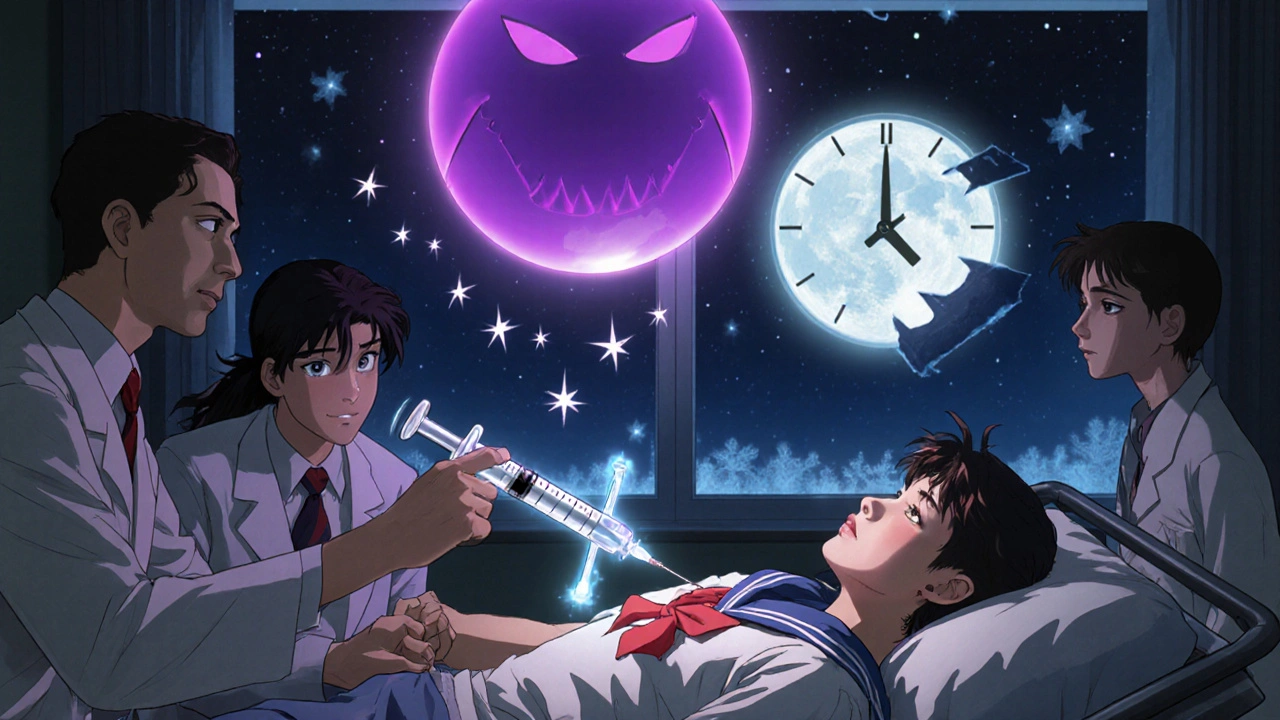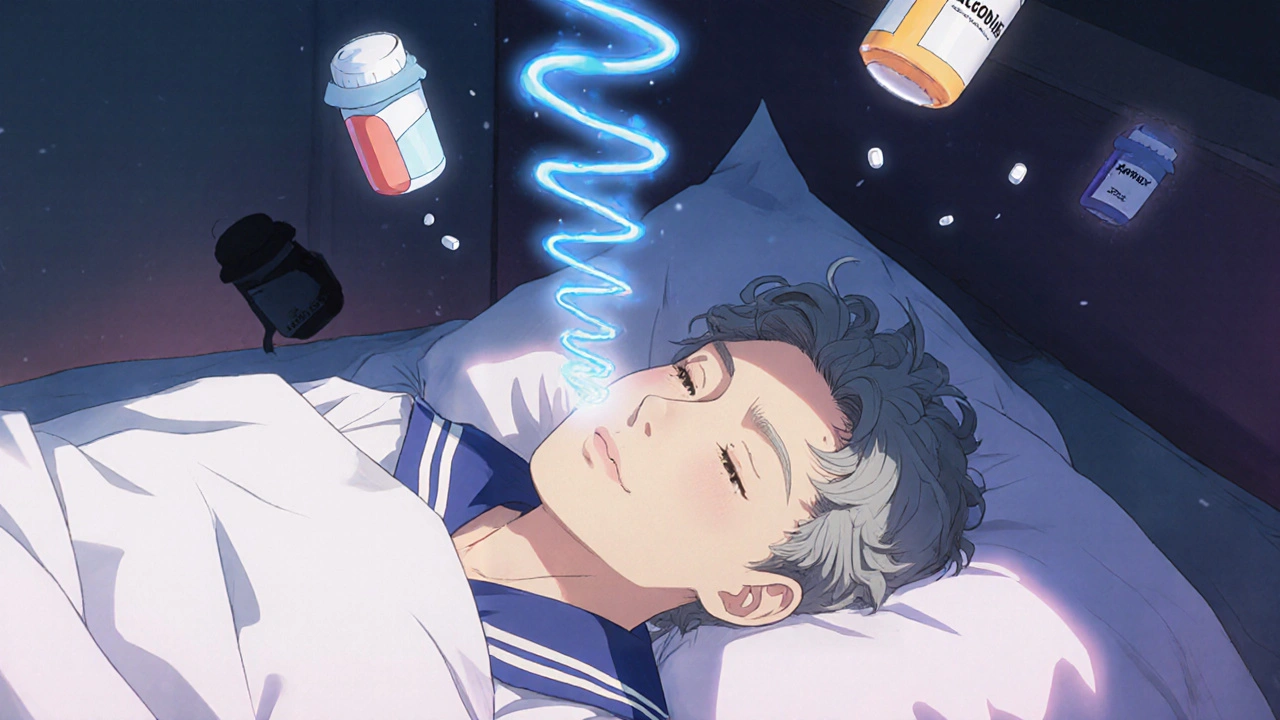Breathing Risk Calculator
Medication Doses
Additional Risk Factors
When you take opioids for pain and benzodiazepines for anxiety, you might think you’re managing two separate problems. But what you’re really doing is putting your breathing on a tightrope-and one wrong step can be deadly. The combination of these two drug classes doesn’t just add up. It multiplies. And the result? Life-threatening respiratory depression.
How These Drugs Quiet Your Breath
Opioids like oxycodone, hydrocodone, or fentanyl work by locking onto mu-opioid receptors in your brainstem. That’s where your body controls automatic breathing. When these receptors activate, they slow down the signals that tell your lungs to inhale. You don’t feel like you’re suffocating-you just take shallower, slower breaths. Studies show opioids stretch out the exhale phase, making each breath longer and less frequent. In severe cases, your brain simply stops sending the signal to breathe at all. Benzodiazepines-like Xanax, Valium, or Klonopin-work differently but end up in the same dangerous place. They boost GABA, the brain’s main calming chemical. This quiets down nerve activity everywhere, including the brainstem. The preBötzinger Complex, the tiny cluster of neurons that sets your breathing rhythm, gets suppressed. So does the Kölliker-Fuse region, which controls how long you exhale. When both drugs hit together, they don’t just add their effects-they amplify them. A 2018 study found that when fentanyl and midazolam were given together, minute ventilation dropped by 78%. Alone, fentanyl cut breathing by 45%. Midazolam alone? Just 28%. That’s not linear. That’s explosive.The Numbers Don’t Lie
In 2019, nearly 1 in 6 opioid overdose deaths involved benzodiazepines. That’s not a small side note-it’s a pattern. For illicit opioids like heroin or fentanyl-laced powder, the number jumps to over 22%. The CDC says people prescribed both drugs are 10 times more likely to die from an overdose than those taking opioids alone. Between 2004 and 2011, emergency room visits from people mixing these drugs rose by 131%. By 2019, the death rate from this combo had climbed 1,800% since 1999. In 2021, over 80,000 Americans died from opioid overdoses. About three out of four of those involved other drugs-and benzodiazepines were among the most common. It’s not just about street drugs. Prescription opioids and benzodiazepines are still being mixed in clinics. A 2022 study found that even after the FDA’s 2016 black box warning, 8.7% of patients on long-term opioid therapy were still getting benzodiazepines at the same time. That’s tens of thousands of people breathing on borrowed time.Why Naloxone Isn’t Enough
Naloxone saves lives. It reverses opioid overdoses by kicking opioids off their receptors. But it does nothing for benzodiazepines. If someone overdoses on a mix of both, naloxone might bring back their breathing-temporarily. But if the benzodiazepine is still active, the brain’s respiratory center stays suppressed. Breathing can stop again minutes after naloxone wears off. That’s why emergency responders now carry longer-acting reversal agents and monitor patients for hours after a mixed overdose. It’s not enough to wake someone up. You have to keep them breathing.
Who’s at Highest Risk?
It’s not just people using drugs recreationally. The highest death rates from this combo are among middle-aged adults-45 to 64 years old. Many are prescribed opioids for chronic pain and benzodiazepines for anxiety or insomnia. They’re not trying to get high. They’re just trying to sleep, or stop the panic. People with sleep apnea, COPD, or other lung conditions are at even greater risk. Their bodies already struggle to breathe. Adding these drugs pushes them past the edge. Older adults are especially vulnerable. Their metabolism slows. Drugs stay in their system longer. Even low doses can build up and suppress breathing without warning.What Doctors Are Supposed to Do
The CDC’s 2016 opioid prescribing guidelines say this clearly: avoid prescribing benzodiazepines with opioids whenever possible. If you absolutely must, use the lowest dose for the shortest time. Monitor closely. Reassess weekly. The FDA’s Risk Evaluation and Mitigation Strategy (REMS) requires prescribers to screen for this combo. Pharmacies are supposed to flag it. Prescription drug monitoring programs (PDMPs) in 16 states now send alerts when a patient gets both drugs. Yet, too many providers still think, “I’ll just lower the dose.” Or, “They’ve been on this for years.” That’s not safe. The synergy doesn’t care about tolerance. It doesn’t care how long you’ve been taking them. It only cares that both drugs are present.What You Can Do Instead
If you’re on opioids and struggling with anxiety or sleep, there are safer paths. For anxiety: SSRIs like sertraline or escitalopram work over time without suppressing breathing. Buspirone is another non-addictive option. Cognitive behavioral therapy (CBT) has been proven to reduce anxiety without drugs at all. For sleep: Non-benzodiazepine sleep aids like trazodone or low-dose doxepin are less risky. Sleep hygiene-regular schedule, no screens before bed, avoiding caffeine after noon-can be more effective than pills. For pain: Physical therapy, acupuncture, nerve blocks, or non-opioid meds like gabapentin or topical NSAIDs can reduce or eliminate the need for opioids. You don’t have to choose between pain relief and peace of mind. You just need the right tools.

Julisa Theodore
October 31, 2025 AT 11:44So let me get this straight - we’re telling people to stop mixing drugs that make them feel human, because science says it might kill them? Cool. Next they’ll ban hugs because they might cause emotional dependency. At least when you’re high, you’re not thinking about how broke you are or how your boss hates you. This isn’t medicine - it’s moral theater with a side of panic.
Lenard Trevino
October 31, 2025 AT 18:50Okay, so I’ve been on oxycodone for my back since 2015 and Xanax since I got laid off in 2020. I’m 52. I don’t do coke. I don’t do heroin. I don’t even drink anymore. But I take my pills. Every. Single. Day. And I’m still here. Alive. Breathing. Laughing at cat videos. So what’s the deal? Is the system scared of people like me? People who aren’t addicts but just… tired? The stats are scary, sure. But I’m not a statistic. I’m a guy who wakes up in pain and goes to bed anxious. You wanna take my pills away? Fine. Give me something that works just as well that doesn’t make me feel like a zombie or a sobbing mess. Until then? Don’t preach. Help.
Paul Maxben
November 2, 2025 AT 14:40THE GOVT IS DOING THIS ON PURPOSE TO CONTROL US. THEY WANT US WEAK. THEY PUT DRUGS IN THE WATER. THEY KNOW THIS COMBO KILLS BUT THEY LET IT HAPPEN BECAUSE THEN WE’RE TOO TIRED TO PROTEST. THEY LOVE IT WHEN WE’RE ZOMBIES. WATCH THE DOCUMENTARY ‘THE BENZO CONSPIRACY’ ON YOUTUBE. THEY’RE USING OUR BREATH AS A WEAPON.
Molly Britt
November 4, 2025 AT 11:04My uncle died from this. They gave him Vicodin for the knee and Klonopin for the ‘nerves’ after his wife left. He didn’t even know he was in danger. Just took his meds like a good boy. Now his kids have to explain to his grandkids why Grandpa never came home. Don’t be him.
Nick Cd
November 4, 2025 AT 19:47you know what’s worse than the combo? the fact that your doctor doesn’t even ask if you’re on benzos when they write you a script for painkillers. they just assume you’re fine. they don’t care. they’re paid by pharma. they’re in on it. i saw my dr’s office get a free vacation to hawaii from a pharma rep last year. they gave me a 90-day script for oxycodone and said ‘oh and if you’re on anxiety meds just don’t tell me’ i was like… huh? that’s not a joke right? they literally said that. the system is broken. we’re all just lab rats with insurance cards.
Patricia Roberts
November 4, 2025 AT 20:18Wow. So we’re supposed to feel bad for taking pills to survive a world that broke us? Meanwhile, the same people who wrote this post are probably sipping kombucha in a yoga studio while their therapist bills their insurance $250/hour. Tell me again how this is about ‘safety’ and not about control? You want people off benzos? Fix the job market. Fix the healthcare system. Fix the loneliness epidemic. Don’t just take away their crutches and call it public health.
Adrian Clark
November 6, 2025 AT 02:43Let’s be real - if you’re mixing these, you’re not trying to get high. You’re trying to feel normal. And the system treats you like a criminal instead of a patient. I know a guy who took his last breath with his meds in his hand and a letter to his daughter on the nightstand. He didn’t want to die. He just wanted to sleep. And now he’s a headline. That’s not prevention. That’s tragedy dressed up as a PSA.
Rob Giuffria
November 7, 2025 AT 09:35Oh look, another sanctimonious lecture from someone who’s never had a panic attack so bad they thought their heart was exploding. You think SSRIs are the answer? Try living with chronic pain and anxiety for a decade while your insurance denies every single therapy session. Then come back and tell me what ‘safer alternatives’ exist when your body is screaming and your bank account is screaming louder. This isn’t about bad choices. It’s about bad systems. And you’re just the messenger with a clipboard.
Ryan Argante
November 7, 2025 AT 18:33While the emotional weight of this issue is undeniable, the clinical evidence presented is both precise and compelling. The pharmacodynamic synergy between mu-opioid agonists and GABAergic modulators is not merely additive but exponentially suppressive of central respiratory drive. The 78% reduction in minute ventilation observed in the 2018 study is statistically significant (p < 0.001) and clinically catastrophic. The persistence of this prescribing pattern despite FDA warnings suggests systemic failures in clinical decision support infrastructure. A multidisciplinary approach - integrating pain specialists, psychiatrists, and pharmacists into coordinated care models - is not optional. It is imperative. The human cost of inaction is no longer abstract.
Barnabas Lautenschlage
November 9, 2025 AT 18:16I’ve been a nurse for 22 years. I’ve seen this play out too many times. The guy who got the opioid after his surgery and the benzo for insomnia because he couldn’t sleep without it. He didn’t even know they were dangerous together. His wife found him in bed, not blue, not twitching - just… still. No struggle. No noise. Just quiet. The worst part? His doctor had prescribed both. For six months. No follow-up. No warning. Just scripts. We need better training. We need better alerts. We need to stop treating symptoms like they’re separate problems. Pain and anxiety are two sides of the same coin - and we’re treating them like they’re different games.
Jeanette Case
November 11, 2025 AT 02:40THIS. THIS IS SO IMPORTANT. 🙏 I’ve been on gabapentin for nerve pain and sertraline for anxiety - and honestly? I feel better than I did on opioids + Xanax. I’m not numb. I’m not zoning out. I’m just… me. I cried when I finally got off the benzos. Not because I was scared - because I remembered what it felt like to wake up without dread. You don’t need both. You just need someone who listens. And if your doctor won’t listen? Find another one. You’re worth more than a prescription pad.